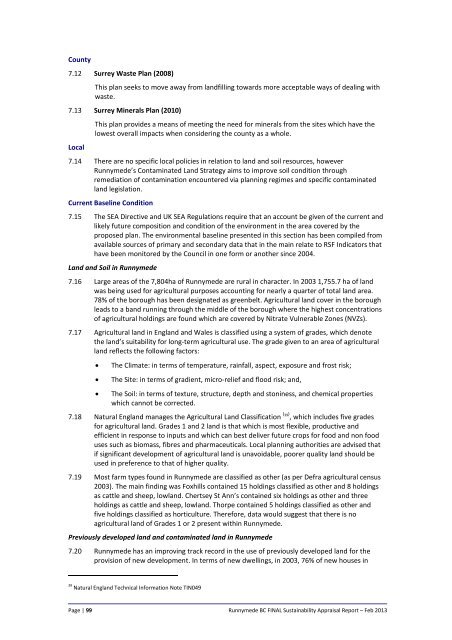DRAFT Sustainability Appraisal Report for the Emerging Local Plan ...
DRAFT Sustainability Appraisal Report for the Emerging Local Plan ...
DRAFT Sustainability Appraisal Report for the Emerging Local Plan ...
You also want an ePaper? Increase the reach of your titles
YUMPU automatically turns print PDFs into web optimized ePapers that Google loves.
County<br />
7.12 Surrey Waste <strong>Plan</strong> (2008)<br />
This plan seeks to move away from landfilling towards more acceptable ways of dealing with<br />
waste.<br />
7.13 Surrey Minerals <strong>Plan</strong> (2010)<br />
<strong>Local</strong><br />
This plan provides a means of meeting <strong>the</strong> need <strong>for</strong> minerals from <strong>the</strong> sites which have <strong>the</strong><br />
lowest overall impacts when considering <strong>the</strong> county as a whole.<br />
7.14 There are no specific local policies in relation to land and soil resources, however<br />
Runnymede’s Contaminated Land Strategy aims to improve soil condition through<br />
remediation of contamination encountered via planning regimes and specific contaminated<br />
land legislation.<br />
Current Baseline Condition<br />
7.15 The SEA Directive and UK SEA Regulations require that an account be given of <strong>the</strong> current and<br />
likely future composition and condition of <strong>the</strong> environment in <strong>the</strong> area covered by <strong>the</strong><br />
proposed plan. The environmental baseline presented in this section has been compiled from<br />
available sources of primary and secondary data that in <strong>the</strong> main relate to RSF Indicators that<br />
have been monitored by <strong>the</strong> Council in one <strong>for</strong>m or ano<strong>the</strong>r since 2004.<br />
Land and Soil in Runnymede<br />
7.16 Large areas of <strong>the</strong> 7,804ha of Runnymede are rural in character. In 2003 1,755.7 ha of land<br />
was being used <strong>for</strong> agricultural purposes accounting <strong>for</strong> nearly a quarter of total land area.<br />
78% of <strong>the</strong> borough has been designated as greenbelt. Agricultural land cover in <strong>the</strong> borough<br />
leads to a band running through <strong>the</strong> middle of <strong>the</strong> borough where <strong>the</strong> highest concentrations<br />
of agricultural holdings are found which are covered by Nitrate Vulnerable Zones (NVZs).<br />
7.17 Agricultural land in England and Wales is classified using a system of grades, which denote<br />
<strong>the</strong> land’s suitability <strong>for</strong> long‐term agricultural use. The grade given to an area of agricultural<br />
land reflects <strong>the</strong> following factors:<br />
<br />
<br />
<br />
The Climate: in terms of temperature, rainfall, aspect, exposure and frost risk;<br />
The Site: in terms of gradient, micro‐relief and flood risk; and,<br />
The Soil: in terms of texture, structure, depth and stoniness, and chemical properties<br />
which cannot be corrected.<br />
7.18 Natural England manages <strong>the</strong> Agricultural Land Classification ( 39) , which includes five grades<br />
<strong>for</strong> agricultural land. Grades 1 and 2 land is that which is most flexible, productive and<br />
efficient in response to inputs and which can best deliver future crops <strong>for</strong> food and non food<br />
uses such as biomass, fibres and pharmaceuticals. <strong>Local</strong> planning authorities are advised that<br />
if significant development of agricultural land is unavoidable, poorer quality land should be<br />
used in preference to that of higher quality.<br />
7.19 Most farm types found in Runnymede are classified as o<strong>the</strong>r (as per Defra agricultural census<br />
2003). The main finding was Foxhills contained 15 holdings classified as o<strong>the</strong>r and 8 holdings<br />
as cattle and sheep, lowland. Chertsey St Ann’s contained six holdings as o<strong>the</strong>r and three<br />
holdings as cattle and sheep, lowland. Thorpe contained 5 holdings classified as o<strong>the</strong>r and<br />
five holdings classified as horticulture. There<strong>for</strong>e, data would suggest that <strong>the</strong>re is no<br />
agricultural land of Grades 1 or 2 present within Runnymede.<br />
Previously developed land and contaminated land in Runnymede<br />
7.20 Runnymede has an improving track record in <strong>the</strong> use of previously developed land <strong>for</strong> <strong>the</strong><br />
provision of new development. In terms of new dwellings, in 2003, 76% of new houses in<br />
39 Natural England Technical In<strong>for</strong>mation Note TIN049<br />
Page | 99 Runnymede BC FINAL <strong>Sustainability</strong> <strong>Appraisal</strong> <strong>Report</strong> – Feb 2013

















